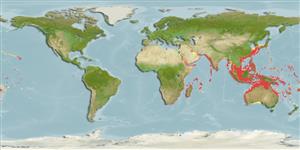>
Elopiformes (Tarpons and tenpounders) >
Elopidae (Tenpounders)
Etymology: Elops: Greek, ellops = a kind of serpent (Ref. 45335).
Environment: milieu / climate zone / depth range / distribution range
Ecologia
marinhas; estuarina; oceanódromo. Tropical; 38°N - 37°S, 22°E - 153°W
Indo-Pacific: Mossel Bay in South Africa, to the Red Sea and India, possibly to western Pacific (Ref. 3968).
Tamanho / Peso / Idade
Maturity: Lm ? range ? - ? cm
Max length : 118 cm FL macho/indeterminado; (Ref. 40637); common length : 50.0 cm SL macho/indeterminado; (Ref. 4967); peso máx. publicado: 10.8 kg (Ref. 40637)
Descrição suscinta
Chaves de identificação | Morfologia | Morfometria
Espinhos dorsais (total) : 0; Raios dorsais (total) : 20 - 27; Espinhos anais: 0; Raios anais : 14 - 18.
Occurs in coastal waters, but enters lagoons and estuaries (Ref. 4832) [actual freshwater records remain to be confirmed]. Benthopelagic (Ref. 58302). Young and adults feed on small fishes and crustaceans (Ref. 5213). Probably spawn at sea, but the transparent larvae migrate to inshore areas and are often found in brackish water (Ref. 7050). Are voracious carnivores that take fish, squid and shrimp bait (Ref. 3968). Edible, but not tasty and full of bones (Ref. 3968). A total length of 126 cm for this species has been reported from Knysna, South Africa (G. Bernardt, pers. comm., e-mail: gerard@smallstreams.com) .
Ciclo de vida ou comportamento de acasalamento
Maturities | Reprodução | Spawnings | Egg(s) | Fecundities | Larvas
Smith, M.M., 1986. Elopidae. p. 155-156. In M.M. Smith and P.C. Heemstra (eds.) Smiths' sea fishes. Springer-Verlag, Berlin. (Ref. 3968)
Status na Lista Vermelha da UICN (Ref. 130435)
Ameaça para os humanos
Harmless
Uso pelos humanos
Pescarias: espécies comerciais; peixe esportivo: sim
Ferramentas
Relatórios especiais
Baixar XML
Fontes da internet
Estimates based on models
Preferred temperature (Ref.
123201): 20.7 - 28.4, mean 26.9 °C (based on 1366 cells).
Índice de diversidade filogenética (Ref.
82804): PD
50 = 0.5176 [Uniqueness, from 0.5 = low to 2.0 = high].
Bayesian length-weight: a=0.00676 (0.00514 - 0.00889), b=2.99 (2.91 - 3.07), in cm total length, based on LWR estimates for this species (Ref.
93245).
Nível Trófico (Ref.
69278): 4.0 ±0.3 se; based on diet studies.
Fishing Vulnerability (Ref.
59153): Very high vulnerability (79 of 100).
